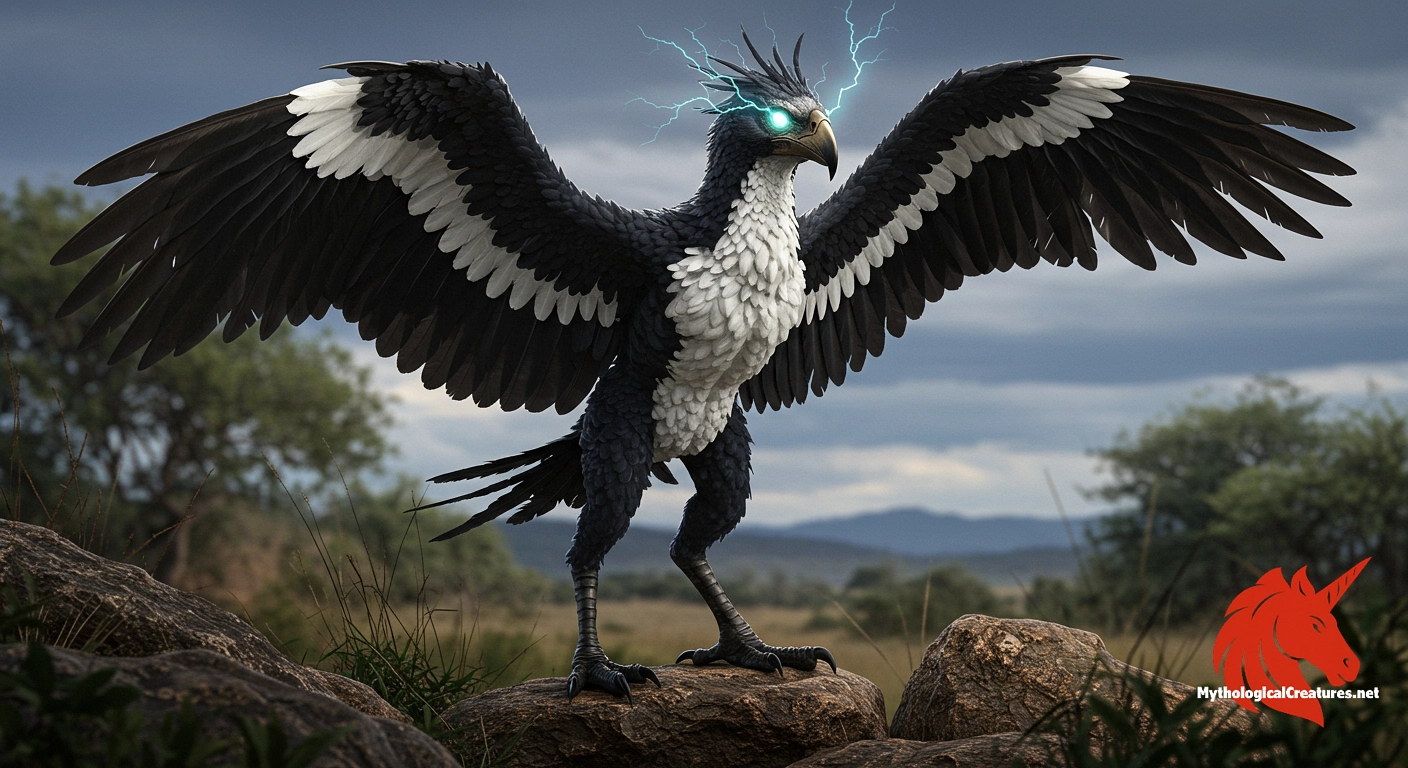Lightning bird: The Lightning Bird, also known as Impundulu, is a supernatural avian creature from Zulu folklore that can summon thunder and lightning with its wings and talons.

Lightning bird
Lightning bird - A supernatural agent that commands thunder and lightning and is used by witches to attack their foes.
Origins & First Encounters
The lightning bird, known as impundulu or thekwane, occupies a formidable space in the folklore of the Zulu people and captivates the imagination with its mysterious presence. Born of the interplay between nature’s fury and supernatural allure, it is portrayed as a striking creature whose form shifts between that of a majestic bird and a seductive human. This mythic being is traditionally depicted as having a dramatic black and white plumage, its size often compared to that of a fully grown person. Its origins appear to be interwoven with ancient traditions that celebrate the power of thunder and lightning as manifestations of the divine. Early attestations in oral tradition speak of its ability to command the elements, summoning thunder with each beat of its expansive wings. Throughout generations, storytellers have imbued it with roles that range from an omen of natural change to a tool of magical practitioners. The lightning bird’s dual identity—at once a bringer of storm and a seducer in human guise—demonstrates a complex balance between beauty and menace. Its enduring presence in folklore highlights a cultural reverence for the untameable forces of nature and the mysteries that lie beyond human understanding. The creature remains a potent symbol in myth, reflecting not only physical might but also the enigmatic intersections of the natural and supernatural worlds.
Source Texts & Tale Variants
Oral traditions among the Zulu people preserve a wealth of narratives about the lightning bird, offering a multifaceted view of its character and powers. These stories, passed down through generations, have been recounted in ritual chants, folklore, and community gatherings, shaping a rich tapestry of myth. In several regional accounts, the creature is depicted either as a formidable avian force or as a cunning shape-shifter, capable of transforming into a handsome young man. Early ethnographic records, though selectively documented, reveal that colonial observers took note of these tales while grappling with their own cultural interpretations. Various versions present the lightning bird as a conduit for supernatural energy, with some storytellers focusing on its tempestuous nature while others highlight its seductive charm. The animal form is often depicted with a beauty that borders on the terrifying, while the human guise introduces layers of intrigue and desire into the narrative. Even within a single community, subtle variations can be found that reflect differing regional beliefs and practices. These diverse tellings underscore how myth evolves with each new recounting and reinterpretation. The broad spectrum of sources testifies to the lightning bird’s versatility as both a literal embodiment of weather phenomena and a metaphor for nature’s unpredictability. In this way, its story continues to be reshaped by cultural memory and the demands of each new era.
Form & Powers
The physical depiction of the lightning bird is as dramatic as the forces it allegedly commands, with many accounts emphasising a striking contrast in its appearance. It is generally described as having a striking plumage marked by alternating bands of deep black and brilliant white, creating a visual representation of night and lightning. Its wings are vast and powerful, seemingly charged with electric energy that ripples through the air when they move. Observers recount that its talons carry an almost palpable intensity, echoing the sharp crack of a lightning bolt as they strike. The creature’s eyes are often said to shimmer with an unsettling luminescence, hinting at its otherworldly nature and a mind that bridges the realms of the mystical and the corporeal. In variants where it adopts a human guise, the lightning bird manifests as a striking young man whose allure hides its inherent danger. Some traditions suggest that even its feathers bear subtle markings reminiscent of storm clouds and crackling energy, as if the very essence of a tempest is woven into its form. The portrayal of its size as comparable to an adult human only adds to the imposing presence of this supernatural entity. Collectively, these physical attributes not only evoke the fearsome power attributed to the creature but also serve as a visual metaphor for the dual forces of beauty and terror inherent in nature.
Regional Faces
Across the diverse cultural landscapes of Southern Africa, regional interpretations of the lightning bird reveal a fascinating array of variations. While the Zulu tradition casts it as a black and white harbinger of storm and magic, neighbouring communities have adapted its image to suit their own cultural narratives. In some areas, similar creatures are seen as divine emissaries that bring rain and ensure fertility for the land, shifting the focus from malevolence to a role of natural beneficence. Other local accounts emphasise the creature’s darker aspects, portraying it as an agent of witchcraft or a spectral guardian of forbidden secrets. In these regions, it is believed that the lightning bird serves those who practise magic, acting as a literal extension of their power. The symbolism of the bird is also adapted to reflect local weather patterns and agricultural cycles, embedding it deeply into the community’s understanding of nature's bounty and wrath. Artistic representations in different regions may vary slightly, with some depicting it in more vibrant or subdued colours while retaining its core attributes. Such regional adaptations highlight the fluidity of myth, showing how a single creature can embody varying aspects of the human relationship with nature. The regional diversity in its portrayal underscores both the universality of natural phenomena and the unique cultural lens through which communities interpret these forces.
Cultural Parallels
When viewed alongside mythological creatures from other cultures, the lightning bird stands as a compelling counterpart to a range of storm-associated beings across the globe. Its ability to summon thunder and lightning finds a clear parallel in the Thunderbird of various Native American traditions, where the forces of nature are similarly personified. Like many of these creatures, the lightning bird represents a dramatic convergence of natural power and supernatural mystique. Its dual capacity for enchanting seduction and terrifying retribution echoes the motifs found in European folklore, where shape-shifters and vampiric figures also straddle the line between allure and peril. The transformation from a fearsome fowl into a beguiling human mirrors broader mythic themes that explore the mutable boundaries between the animal and human realms. Across different cultural contexts, such beings serve as enduring metaphors for the unpredictability of nature and the inherent dangers of unchecked power. The comparative framework suggests that while the lightning bird is unique in its specific cultural context, it also partakes in a universal mythological dialogue about the interplay between beauty, danger, and the elemental forces of the natural world. By drawing on these cross-cultural parallels, the myth of the lightning bird becomes part of a larger narrative mosaic that spans continents and histories. Such interconnections reveal the shared human fascination with characters that embody the dual nature of creation and destruction.
Legacy & Modern Evolution
The legacy of the lightning bird has evolved dramatically over time, taking on new layers of meaning as cultural contexts shift. In its earliest incarnations, the myth served as a potent explanation for the unpredictable forces of nature and the mysterious interplay between natural storms and supernatural events. As modernity advanced, the lightning bird began to represent more than just a fearsome storm-bringer—it came to embody the complex interplay of power, transformation, and seduction. Contemporary reinterpretations in art, literature, and film have reimagined it as a symbol of both ancestral identity and the tension between tradition and modernity. The creature’s vampiric allure and dual forms continue to captivate audiences, allowing it to serve as a bridge between ancient oral traditions and the modern narrative landscape. Modern depictions often emphasise its role as a cultural icon, with artists celebrating its dynamic symbolism during festivals and exhibitions. As the myth has been reworked over time, it has also come to signify resilience and the enduring spirit of indigenous storytelling. Its evolution reflects a broader trend in which traditional myths are continually recontextualised to communicate contemporary concerns and cultural pride. Today, the lightning bird remains a vivid reminder of the timeless human urge to explain the mysteries of life through the rich symbolism of myth and nature.
Interesting Fact
In some versions of Zulu lore, the sighting of a Lightning Bird is considered an ominous sign, heralding significant natural and spiritual upheavals.
Quick Creature Info
Origin:
Associations:
Our Mythic Legendary Rating:

Also Sometimes Known As:
Habitat:
Supernatural Powers:
Physical Attributes:
Abilities:
Behavior:
Lore:
References
Discover Another Mythical Legend You May Not Have Heard Of?
Uncover the mysteries of ancient folklore and expand your knowledge of legendary beings from cultures around the world.
Dare to Meet the Bölþorn....
Curated by the Mythological Creatures Team (rev. May 2025)
